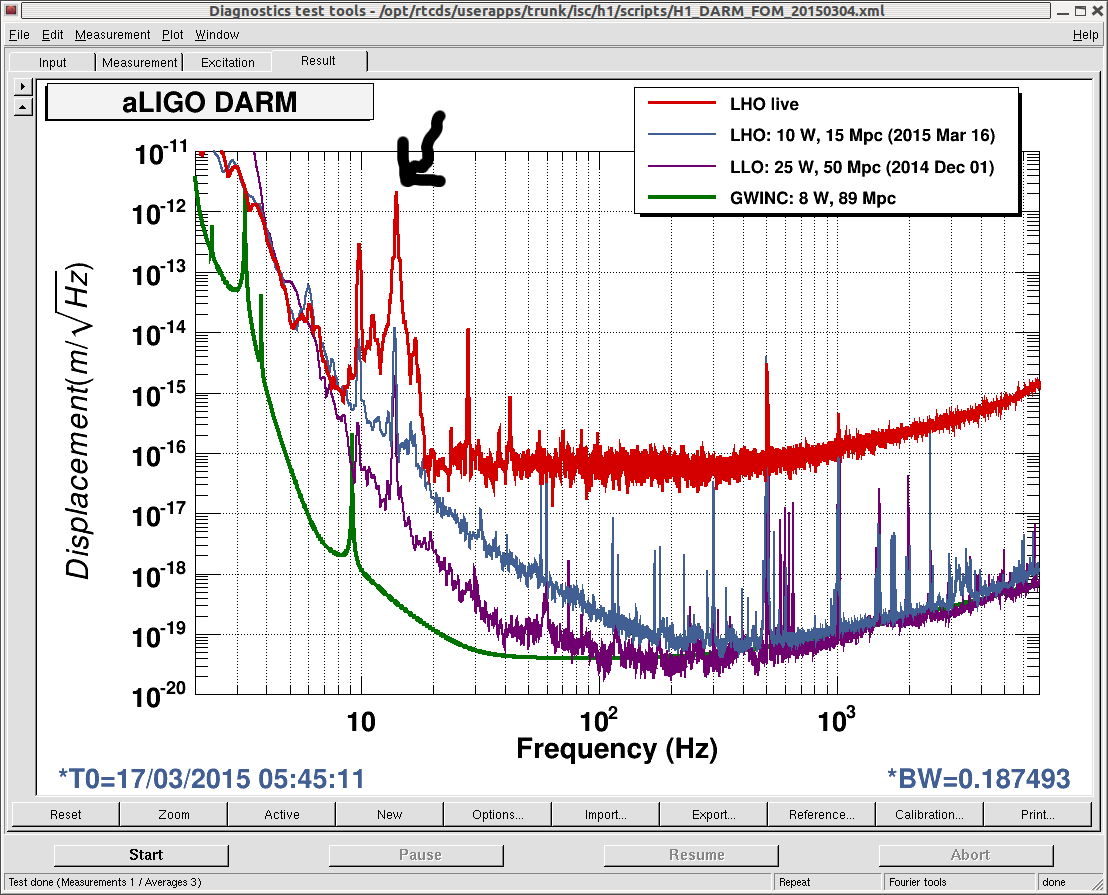Dan, Kiwamu,
At one point last night, we noticed that a roll mode rang up at ~14 Hz. The peak height in the DARM spectrum (ffted with a 0.1 Hz BW) exhibited a anomalously high value of more than 10-12 m/sqrt Hz.
So we worked on damping the peak, this time with the AS_WFS_A_45Q signal (alog 16864) which is a state-of-the-art Livingston technique. We were successfully able to damp the mode to an ordinary height of about 10-14 m/sqrt Hz level in the DARM spectrum.
(Identification process)
First of all, see how terrible the roll mode was:
The red curve is from Mar-17-2015 8:51:00 UTC and we were intentionally stayed on the rf DARM rather than the DC readout to combat the roll mode. Even though there was some confusion in identifying which suspension had been rang up, eventually we confirmed that the roll mode was from ITMX by taking coherence between AS_WFS_A_45Q and the OPLEV_PIT signal of each test mass. In fact, the ITMX oplev was able to see the roll mode in its spectrum with a peak ~ 10 times higher than the noise floor while the rest of the oplevs did not see a visible peak.
In addition, after the successful damping on ITMX, the AS_WFS_A still showed a bit high peak but with a slightly lower frequency (~ 200 mHz ) than that of ITMX. We then identified that this was in turn from ETMY by looking at the coherence again. This lead us to another damping work on ETMY which we were also able to damp.
(Damping setup)
The AS WFS_A signal was routed from the ASC model with a gain of +1 (in ASC_OUTMATRIX_TESTMASS_DAMP). I found that both were damped well with a positive gain in SUS-E(I)TMX(Y)_M0_DAMP_R.
As for ITMX, I ended up with FM3 (-100 dB), FM4 (bp13.9) and a gain of +40. Although I had to start from a gain of +1 in order not to saturate the DAC due ot the high amplitude in the roll mode. Then I gradually increased the gain as the DAC counts reduced. Once I went to a gain of more than 10, the mode was damped relatively quickly probably on a time scale of about a couple of minutes.
As for ETMY, I ended up with FM4 (bp13.9) and a gain of +0.0008. At one point I went to a gain of +0.005, but this actually started increasing the peak height. So I had to set the gain back to + 0.0008. This loop could damp out the mode on a time scale of a couple minutes as well.
(Why they rang up ?)
We don't know. One observation is that before the modes rang up, Sheila was trying to increase the recycling gain by manually touching the ITMs.
What's the exact frequency (or at least to ~0.01 [Hz] precision)? Remember, I was able to distinguish two mode frequencies in LHO aLOG 16868: a 13.18 [Hz] mode or the 13.81 [Hz] mode, which I'd narrowed down to an ITM and an ETM mode respectively. It would be good to catalog is the ITMX mode you say rung up. @DetChar -- you're more than welcome to answer this, if Dan or Kiwmau can't get back to it quickly. The time you should use is listed in the bottom corner of the DTT screen capture.
since the color of the Time text is the same as the reference, I guess that's not the right time. Better to use the time of the RED live trace.
Looks like about 13.98 Hz, accurate to 0.01 Hz. I used 5 mins of data, 120 sec FFT, overlap of 0.9. I used the time mentioned in the log entry (8:45 UTC Mar 17) since the data didn't look right around the time in the DTT screen. We don't have a nice tool for quickly marking the peaks in spectra. I'll look into making one.


